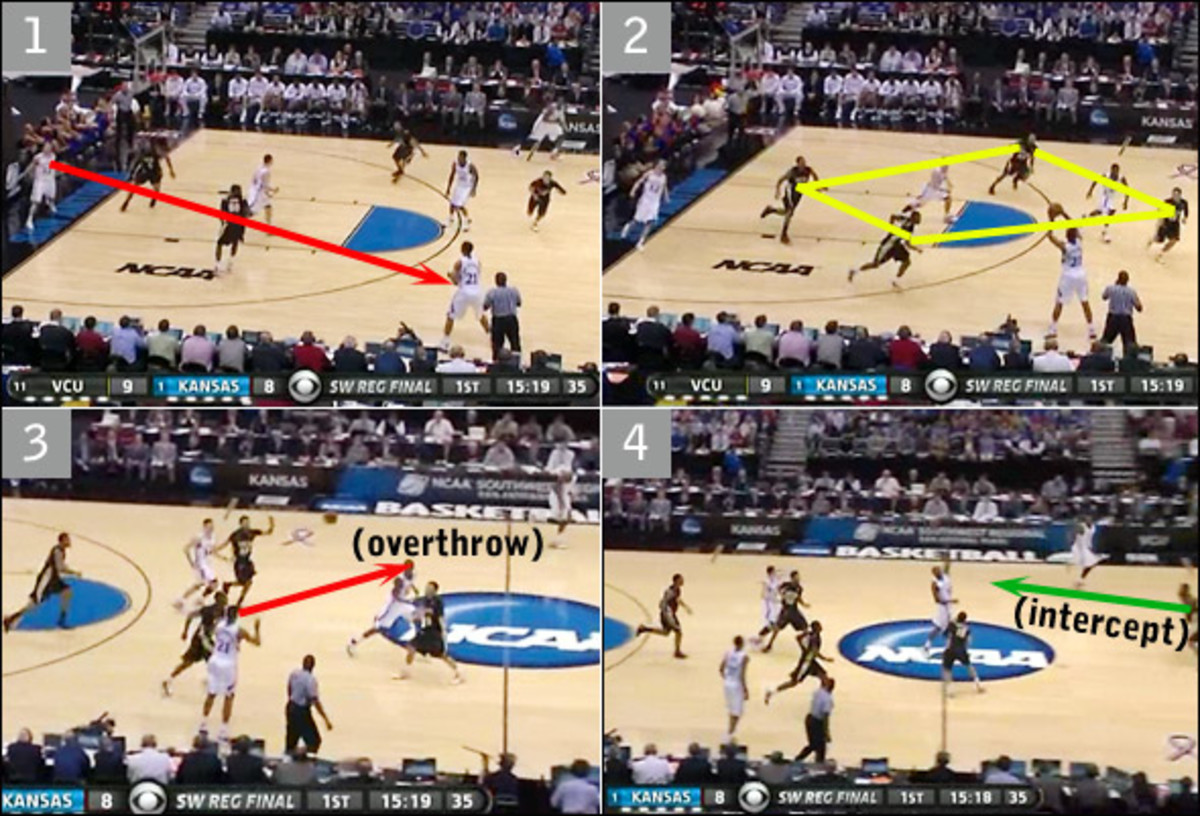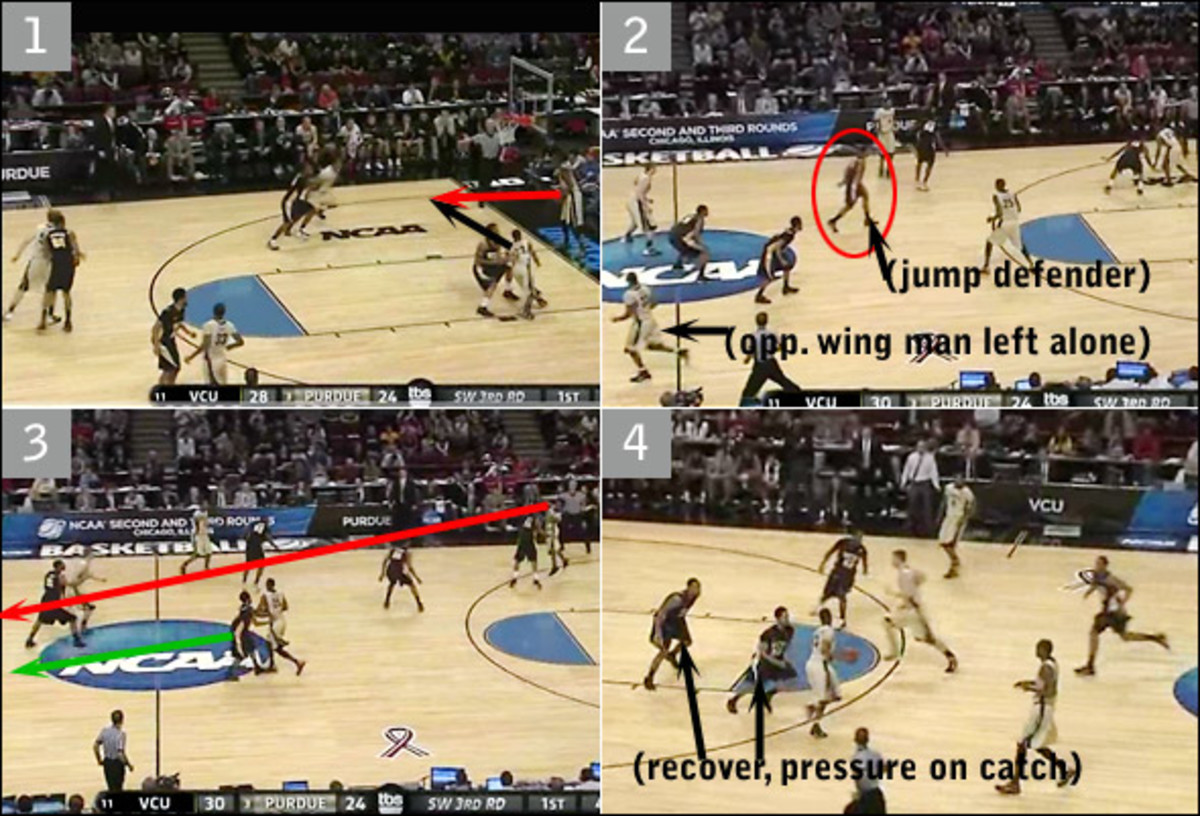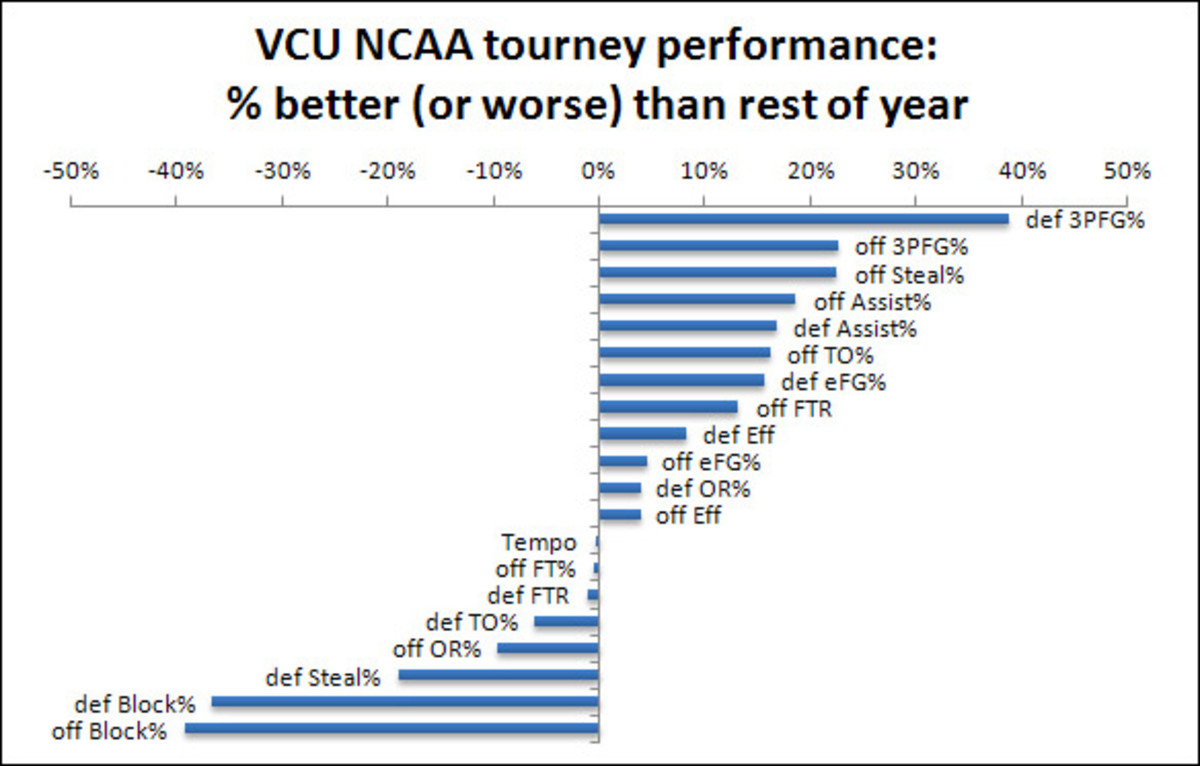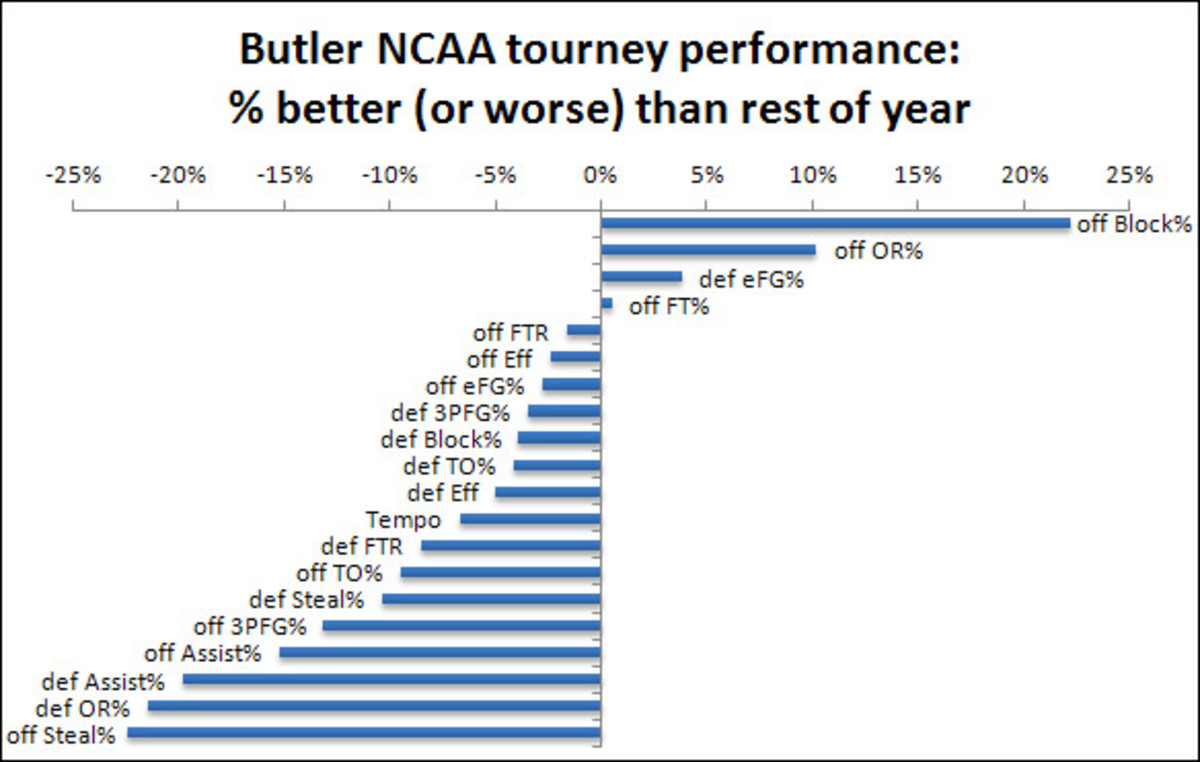The Final Four Intel Report


Joey Rodriguez and VCU will look to put the heat on Butler in the Final Four. (Jamie Squire/Getty Images)
Four doses of Final Four knowledge, on the morning of the semifinals:
I. Understanding "HAVOC": How VCU's press will attack Butler
Butler would prefer not to play a fullcourt game. The Bulldogs are the 270th-slowest team in the country, at 64.6 possessions per game, and 90.4 percent of their offensive possessions this season were halfcourt sets. The fact that they struggled with Wisconsin's impromptu press in the Sweet 16, letting the Badgers whittle a 20-point lead down to four in the final two minutes, leads one to believe that VCU -- a team that presses on made baskets with regularity -- will bring the heat on Saturday. Coach Shaka Smart has branded the Rams' style of play as "Havoc," and as junior guard Bradford Burgess said, "There's a full court for a reason."
The 33-year-old Smart received much of his offensive education in the year he spent under Billy Donovan at Florida, but the VCU coach's biggest defensive influence is the man who hired him at Dayton and Clemson, Oliver Purnell. A major proponent of the press, Purnell's primary scheme has long been the "Diamond," or 1-2-1-1 zone. Smart has adopted this at VCU, and it figured prominently in the Rams' assault on Kansas in the Elite Eight. "We felt like, because the [Jayhawks] didn't have a true point guard, the press could work," said assistant coach Mike Jones. Butler's starting backcourt of Shelvin Mack, Shawn Vanzant and Chase Stigall doesn't include a true point guard, either; that means Ronald Nored, the starting point during last year's title-game run, may need to play major minutes off the bench to solve the pressure.
Here are two ways the diamond forced turnovers against Kansas:
• The goal of the diamond, which has a man guarding the inbounder and two defenders spread out on the three-point wings, is to force the opponent to catch the ball in the "coffin corner," where the sideline and baseline intersect, and then aggressively trap him. That happens to KU's Tyrel Reed in frames 1 and 2. The weakside defender prevents a pass back to the inbounder, and then the midcourt defender (in this case, Joey Rodriguez in frame 3) comes up to play safety against long passes out of the trap. When Reed tries to find Tyshawn Taylor near the center circle, Rodriguez steps up and snares the ball (frame 4), then converts it into a layup.

• In this second example, the Jayhawks avoid the coffin-corner inbounds pass and hit Markieff Morris (frame 1) near the hashmark. The diamond (formation seen in frame 2) then scrambles to either trap Morris or take away his passing options. He panics while looking for Taylor near the center circle, throwing it over his head because Rodriguez has stepped into the passing lane. The backline defender then steps up to gather the loose ball, and looks to score in transition.

The Rams also use a "run and jump" man-to-man press on occasion, and this too was borrowed from the Purnell playbook. The example below is from their second-round win over Purdue; you can see that in this case, they don't pressure the inbounder, but they attempt to deny the easy inbounds pass (frame 1). The jump defender, who had been guarding one of the Boilermakers' big men, starts lurking, looking for a trap opportunity (frame 2). Since VCU is playing 5-on-4 in the backcourt, it allows E'Twaun Moore to get free on the opposite wing, and tempts Purdue into throwing a long, upcourt pass. The back of the press recovers in time to pressure Moore soon after the catch, and forces him to throw the ball away.

II. Where Kentucky failed the first time
Awful, awful first question to the UConn press conference on Friday, by someone who apparently wasn't aware of the existence of the Maui Invitational:
Reporter: "Kemba [Walker], have you faced a defender this year like DeAndre Liggins, a guy much taller than you with long arms? What kind of problems does that present to you?"
Kemba Walker: "We actually played against them already, so I faced him already."
This happened on Nov. 29, when Walker had 29 points in an 87-64 rout in the Maui title game. As Liggins, who guarded him for most of the game, said on Thursday, "Kemba killed us."
Liggins, whose rep as a defensive stopper has improved since then, would surely like another shot at the guy who killed him in the season's first month. The promising thing, for the Wildcats, is that while Walker made a few absurd shots in that game on soundly defended possessions, they also had a number of easily fixable lapses that led to Walker baskets. Here are three areas they'll no doubt address in their UConn scouting report:
• Ballscreen defense. The frames below show how UK defended UConn's first ballscreen of that game. It wasn't pretty. While Liggins tries to fight over the screen, freshman forward Terrence Jones, playing in just his fifth college game, hedges tentatively, and not nearly long enough for Liggins to recover. Jones' early retreat from Walker's path essentially gave him a clear lane to the rim for a floater. Don't be surprised if the Wildcats double Walker off of ballscreens this time around.

• Late closeouts. In the left frame, Liggins isn't vigilant enough about staying tight with Walker in a spot-up, halfcourt situation, and Walker rises up for an easy three without as much as a hand in his face. In the right frame, the Wildcats allow Walker to get loose in transition, and the closest defender to him, Darius Miller, chooses to sag back and protect the lane rather than pressure the ball. He, too, gets burned by a three.

• Risky over-plays. Later in that game, Liggins tried to start denying Walker the ball when he'd cut to the perimeter to receive passes. The strategy wasn't all that successful, as Walker countered by back-cutting while Kentucky had no one protecting the rim. In the frames below, he and Shabazz Napier execute a perfect back-door play that leaves Liggins flailing out beyond the arc:

III: The statistical abnormalities of VCU-Butler
Thanks to some excellent research from Tourney Blog collaborator David Hess, the man behind The Audacity of Hoops, we can examine each Final Four team's tournament performance across 20 categories, and see how much better or worse (in terms of percent) it is in relation to their regular-season numbers.
VCU, as we've mentioned before, is playing well above its season-long identity in a number of categories. Most of the talk has been about the Rams' superhuman three-point shooting, but Hess reveals that we should be focusing on their three-point defense instead. They've had almost a 40 percent improvement in their defensive three-point percentage during the dance:

Butler, meanwhile, has strayed from its traditional profile in one big way: Instead of controlling the defensive glass, as it did much of the season (and in last year's tournament as well), the Bulldogs are giving opponents over 20 percent more offensive boards. Butler has compensated for this by experiencing a 10 percent surge in its own offensive rebounding, in large part due to freshman Khyle Marshall, their glass-crashing "energy guy" off the bench:

IV: The statistical abnormalities of UConn-Kentucky
More from the Hess Files: The Huskies' seven-year reign over the national defensive block percentage standings came to an end in 2010-11, with Syracuse stealing the title. If it's any solace to UConn fans, at least they're not getting any of their own shots blocked in the NCAA tournament; 60 percent fewer of their shots are getting swatted in the dance than the regular season. Somehow they managed to not let Arizona's Derrick Williams record a single block in the Elite Eight.

Our charts show that Kentucky's defense is surging in three categories: blocks, free-throw rate, and three-point percentage allowed. Considering the ugly images we showed in section II, this is a good sign. The Wildcats have figured out ways to contest three-point shooters while not fouling as much on drives. They should make life tougher on Kemba than they did in Maui, but that doesn't mean they'll stop him altogether. There's no formula for that. The tapes of his past nine games make for one horrific scouting-report reel.

